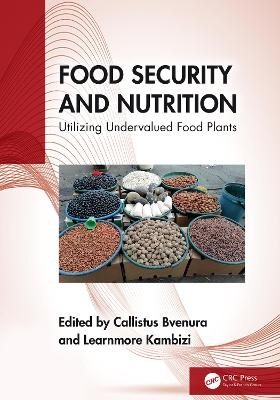
Food Security and Nutrition
CRC Press (Verlag)
978-1-032-73655-6 (ISBN)
- Noch nicht erschienen (ca. Dezember 2024)
- Versandkostenfrei
- Auch auf Rechnung
- Artikel merken
Food Security and Nutrition: Utilizing Undervalued Food Plants explores the potential of underutilized and indigenous food plants to enhance food and nutrition security amid global challenges, such as climate change, water scarcity, and population growth. It emphasizes the importance of dietary diversification to reduce dependency on major staple crops, highlighting the nutritional and health benefits of lesser-known crops, such as fonio, pigeonpea, finger millet, and a wide array of wild vegetables and mushrooms. The book reviews innovative farming techniques, like the organic medium–enclosed trough system and hydroponics, which improve crop yield and nutrient content while conserving resources. Additionally, it addresses the commercialization potential of indigenous fruits and wild herbal teas, emphasizing their market value and health benefits. The book also discusses the reduction of goitrogenic compounds in certain crops to mitigate health risks.
By examining the unique nutritional profiles and local adaptability of these crops, the book advocates for their broader use to build a more resilient and sustainable food system. Through a combination of scientific research, practical farming methods, and market strategies, the book aims to promote food diversity, improve health outcomes, and support sustainable agricultural practices.
Key Features
Highlights the critical role of dietary diversification in reducing dependency on major staple crops, advocating for the inclusion of lesser-known, nutrient-rich plants to improve overall health and nutrition.
Introduces cutting-edge farming methods, such as the organic medium–enclosed trough system and hydroponics.
Explores the market value and health benefits of indigenous fruits and wild herbal teas, offering strategies for their commercialization to boost local economies and food security.
Addresses the reduction of harmful compounds, and provides practical solutions to mitigate associated health risks and enhance the safety of food consumption.
Dr Callistus Bvenura graduated with a BSc in Natural Resources Management and Agriculture in 2006 from the Midlands State University, Zimbabwe and completed his PhD Ethnobotany from the University of Fort Hare, South Africa in 2014. His areas of specialization encompass interdisciplinary research at the intersection of plant biology, ethnobotany, food science, agriculture, and public health, with a focus on promoting sustainable food and nutrition security through the utilization of diverse plant resources. Callistus’ research profile is comprehensive, including co-edited books, numerous peer reviewed research articles, book chapters and review papers in these focus areas and is constantly presenting his research findings at local and international conferences. In addition, he has interests in product development where he and his fellow colleagues developed Niselo, a probiotic sorghum beverage which has since then been commercialized in South Africa and the United Kingdom. He is also part of a team that developed broiler chicken feed using indigenous and underutilized grains and insects. Furthermore, he is a South African National Research Foundation rated researcher and panel expert reviewer. Dr Bvenura is also an editorial board member of the Journal of Medicinal Plants and Economic Development (JOMPED) and reviews for several local and international journals. Prof Learnmore Kambizi attained his BSc degree from Cuba in 1998 before enrolling for Masters and PhD degrees at the University of Fort Hare which he completed in 2004. His PhD focused on Ethnobotanical studies of plants used for the treatment of sexually transmitted infections in South Africa. He went on to pursue a postdoctoral fellowship within the fields of Ethnobotany & Phytomedicine. This discipline enabled him to realise his passion for sustainable utilisation and conservation of medicinal plants on a local and international level. He worked as a Lecturer at the University of Zimbabwe in 2005 before moving to the University of the Free State, South Africa in 2007. In the same year, he was appointed by Walter Sisulu University as a Senior lecturer until 2011. He moved to Cape Peninsula University of Technology, South Africa where he is now a Full Professor of Botany. In his academic journey to date, he has hosted 4 postdoctoral fellows and supervised 5 PhD, 16 master’s and numerous Honours students. In addition, he has edited and published a book, published numerous articles in peer reviewed journals and presented at many national and international conferences. He recently edited a book titled “Sustainable uses and prospects of medicinal plants”. He is a South African National Research Foundation rated researcher. Prof Kambizi has also served as a panel member of the National Research Foundation of South Africa and has received many research grants to support post graduate students and to assist communities. He also collaborates with Traditional Medical Practitioners in collaboration with the South African Research Council as an advisor. In addition, Prof Kambizi was appointed the first Director of African Centre for Herbal Research based in Nigeria, a position he holds to date. He is a reviewer of many national and international journals.
Chapter 1. The future of undervalued indigenous crops: a brief overview. Chapter 2. The contribution of underutilized fruits and vegetables to enhanced food and nutrition security: A review. Chapter 3. Exploring the hidden potential of undervalued food plants for nutrition and health security. Chapter 4. Optimizing food and nutrition security: Exploring the nutritional potential of finger millet and insect protein for enhanced growth and sensory benefits in broiler chickens. Chapter 5. Characterization of selected nutritional traits in spider plant (Cleome gynandra L.) leaves. Chapter 6. Are wild mushrooms a panacea for food and nutrition insecurity? Chapter 7. The potential of underutilized and undervalued Moringa oleifera plant accessions for nutritional and food security. Chapter 8. The cultivation, nutritional, polyphenolic contents, bioavailability, and health benefits of finger millet (Eleusine coracana (L.) Gaertn): An updated review. Chapter 9. Exploring the potentials of underutilized leafy vegetable Corchorus olitorius L. Chapter 10. Exploring nutrient profiles in overlooked food plants for enhanced food security and nutrition. Chapter 11. Mineral constituents and bioactive compounds of finger millet grain. Chapter 12. Underutilized plants and hidden hunger: Suitability of hydroponics for achieving diet diversity. Chapter 13. Optimizing nitrogen fertilizer for enhanced growth, mineral enrichment, and yield of Phaseolus vulgaris in hydroponics for improved food and nutrition security. Chapter 14. Novel applications of undervalued herbal teas for food and nutrition security and the prevention of malaria. Chapter 15. Cultural perspectives, nutritional and health values of wild edible plants among the FBatswana of southern Africa. Chapter 16. Exploring some cape wild foods: implications on future food and nutrition. Chapter 17. Potential for the exploitation of nutritional traits of sweet sorghum (Sorghum bicolor (L.) Moench) in food systems. Chapter 18. Nutraceutical, agricultural, and economic potential of Trachyandra ciliata (Wild cabbage), an under-utilized halophyte from the Western Cape province, South Africa. Chapter 19. Exploring the nutritional wealth of edible members of the genus Vitex: insights into health benefits and nutrient bioavailability. Chapter 20. Exploring the nutritional profile of tepary bean (Phaseolus acutifolius) and evaluating seed protein alterations caused by chemical mutagenesis. Chapter 21. Exploring the food security and nutrition potential of Digitaria exilis. Chapter 22. Leveraging underutilized food plants for food and nutrition security: selected nutritional attributes in pigeonpea (Cajanus cajan) seed. Chapter 23. Organic medium enclosed trough system: A climate smart technology for enhancing indigenous vegetable productivity and nutritional constituents. Chapter 24. A survey of goitrogenic compounds in selected millets and cruciferous vegetables: nutritional downside. Chapter 25. The untapped potential of wild and underutilised fruits in the development of novel commercial products in Africa. Chapter 26. Sustainable food production and prospects: A fundamental guide to hydroponic agriculture.
| Erscheint lt. Verlag | 24.12.2024 |
|---|---|
| Zusatzinfo | 79 Tables, black and white; 13 Line drawings, color; 24 Line drawings, black and white; 30 Halftones, color; 3 Halftones, black and white; 43 Illustrations, color; 27 Illustrations, black and white |
| Verlagsort | London |
| Sprache | englisch |
| Maße | 178 x 254 mm |
| Themenwelt | Medizin / Pharmazie ► Gesundheitsfachberufe ► Diätassistenz / Ernährungsberatung |
| Technik ► Lebensmitteltechnologie | |
| Weitere Fachgebiete ► Land- / Forstwirtschaft / Fischerei | |
| ISBN-10 | 1-032-73655-0 / 1032736550 |
| ISBN-13 | 978-1-032-73655-6 / 9781032736556 |
| Zustand | Neuware |
| Haben Sie eine Frage zum Produkt? |
aus dem Bereich


